-
Posts
3,342 -
Joined
-
Last visited
Content Type
Profiles
Forums
Gallery
Events
Posts posted by amateur
-
-
Still struggling with the idea that this is paper

Jan
- DORIS, coxswain, Farbror Fartyg and 4 others
-
 7
7
-
From personal experience, it is neither hard nor to costly to order Seawatch Books books from Europe. I bought my 4 copies of David Antsherl's Swan Class books through an English bookshop in Paris for a reasonable price (and no paperwork...). Internet ordering is not the only option...
And ordering a few books at the same time helps reduce the shipping costs, that's for sure.
I did ask this at a couple of bookstores around, but what they do is: go to the website, order the book, and ask me to pay book price, taxes, fees and other legal stuff taht I would pay by ordering through internet myself, and a 'handling fee' for themselves on top of this.
As far as I have discovered by now, there is no way to circumvent these high imports (and if someone knows how, please give a response....)
And yes, ofcourse amazon is available, but in principle the package will only be cleared by customs after paying the legal amounts. (tax free import by mail is, as Carl mentioned above: 22 euro).
[edit] And : check the proices of the Swan series on Amazon: you can almost buy all seawatch books for that amount....
Jan
-
Just a thought, but if these books are so great, and hard to acquire overseas, maybe the book could be made available in a secure electronic format like Kindle books? You could still charge and make a profit, but it would make it so that those who don't want to double the book's price by shipping it could still have the ability to benefit from the contents? I still like paper books for research and learning better than e-books....but still worth thinking about?
In the Netherlands there is 'Uitgeverij Van Wijnen' (http://www.uitgeverijvanwijnen.nl/) they have the the book on Valkenisse already in their list, and they have the Dutch version of the Hoving-book on the Utrecht.
A second one firm is Lanasta (http://www.lanasta.com/), developping a nive portfolio of modelling and maritime books for the Dutch market.
Would either of these two be an option as 'import-partner' for the Seawatch-range?
Importing in bulk (or as Klaus suggests even printing the books here), might be a method to lower the relative effect of the import and tax on the bookprice.
Jan
-
I know that these chainplates are more to scale than your homemade ones from wire that are used in your first build.
But, to be honest, I like the home-made ones better that the etched ones. But perhaps that is due to the fact that these are still a bit blingy.
Jan
-
That's detailing to the limit...
You will be forced to remove microscopic dust particles, otherwise we will think that's just intended there to be

Jan
-
Why not?
You will be doing the same with your Wasa in a while

Jan
-
That was me and wayne, but it was just the remark that the Dutch charter is the only one explicitly stating both spritsail topsails and staysail (no jib)
btw Andersson (1927) states that there is a time window of about 50 years (1650-1700) in which probably ships had the option of
using both stay-sails and spritsail topsails.According to him, before 1650 no staysails were reported, after 1700 no spritsail topsails are mentioned. In the intermediate period both were mentioned (and on the same ship)
Jan
-
Hi Carl,
It is less serious than you suggest, but still....
Seawatch let us pay $25 for transport, and Dutch customs let you pay around 6% of the total value of the package (wihich is inclusing trasportation and insurance costs).
A book of $70, will therefore cost you (70+25)*(1.06) = $100.
I do hope Seawatch will go and find a European firm to import the books and sell them at a more compatible price....
Uitgeverij Van Wijnen import the book on Valkenisse by Napier, selling it for 89euro, but that is even ore than the price you have to pay by importiong it yourself.....
Jan
-
Beleive it or not: I did something today!
Ratlines on the futtock shrouds of the main mast (port side only
 )
)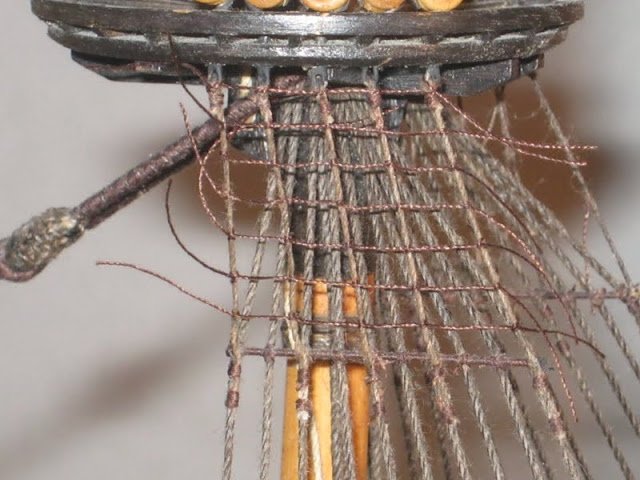
Not much, but at least a hundred times more than the previous three months!
Jan
- dafi, avsjerome2003 and john a joosten
-
 3
3
-
I used a dark brown (oak, it's called) water based stain on my standing rigging.
Black is just too black for my idea.
Any very dark brwon will do, I guess. Be aware that the material you use, as well as your method of dying does result in different shades of brown. So thinking ahead is worthwhile.....
Jan
-
Common Carl. Why don't you simply come to the States, visit Carl, see what he is like and buy his book. That would be fun, right?
Ik weet zeker dat zijn boek prachtig zal zijn, dus geen negativa posting meer, alst-u-blieft. Or however you want to say that.
No negative on the book (which undoubtedly) will be great, as other seawatch-books are.
But I have to agree with Carl that the import- and transport fees to be paid on US-imported books are rather high.
And as to visit the US, the amount of paperwork needed for that is killing any fun of going.....
Jan
-
I posted something just before they changed to the new dedicated MSWserver.
Apparently my post never reached it's destination....
I made two remarks
- the game was almost dead on MSW 1.0, so I'm not sure whether or not it will revive here. Many of the "major" players stopped playing (something like: we've seen/posted them all)
- another rule: to prevent misunderstandings and utter confusion: it is to the poster to follow the thread as long as its ship was not found, and to be the judge of the proposed solutions. So, without the consent of the poster, the next one is not to post a new ship.
And as a PS:
- don't forget to rename your pictures: the first one posted by PRM is named Bismarck 1.jpg, which gives it away rather easily

-
Without you being able to check the past of the game, I could as well repost the old ones

Jan
-
And now, I should really return to my build before I can show you anything new......
Jan
-
After stays and shrouds, backstays are to be installed.
The most interesting of these is the one one the spritsail topmast:
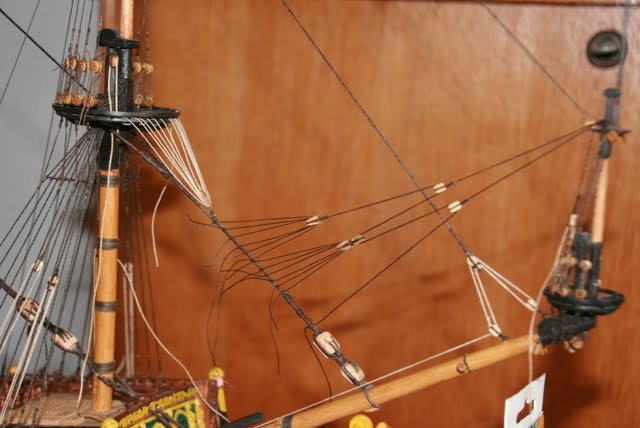
getting the tension in this one right is almost impossible, as the tension of the forestay is far too low for a proper tensioning of the fore stay: either the fore stay is pulled forward, or the topmast backward (or both
 ) As the crowsfeet are attached to the stay at both ends, the tensioning of these was tricky: it should be straight, but not exert any force on the stay. The fun of it was to get all strings at a comparable tension. I did not completely succeed, but I'm content with the result.
) As the crowsfeet are attached to the stay at both ends, the tensioning of these was tricky: it should be straight, but not exert any force on the stay. The fun of it was to get all strings at a comparable tension. I did not completely succeed, but I'm content with the result.The other backstays are attached to the hull (not to the channels), the lower one by a tackle (upper violin block ,lower a single block), and the upper backstay is attached to the hull by a somple lashing, which is attached to the stay through an eyesplice:
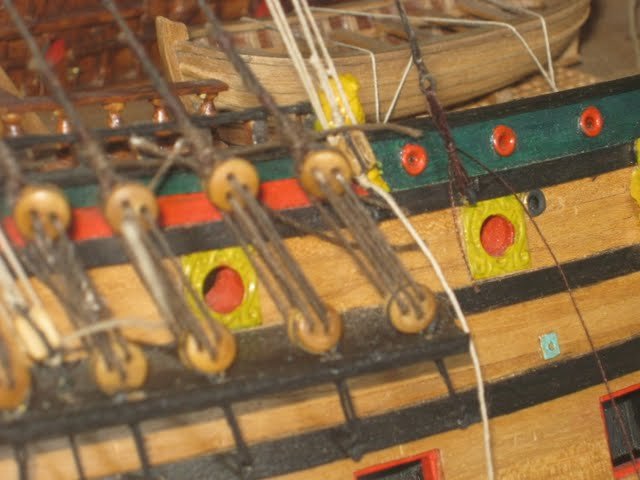
And the fiddle-block:
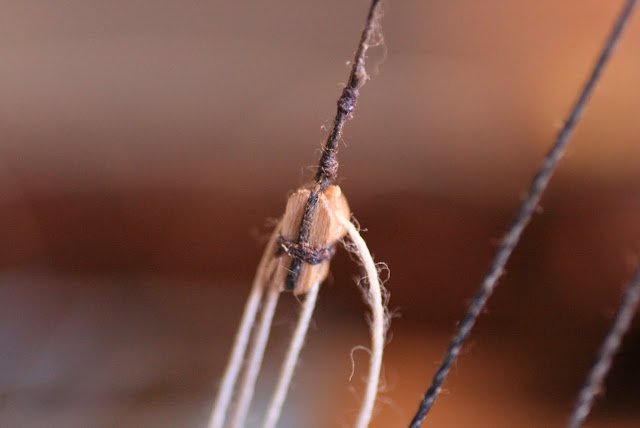
The 7 mm fiddle block is not quite according to Dutcj standards, but it will do for me (at least, I don't have the patience to make my own blocks. By doing an seizing in the middle of the block, I try to cover up the mismatch in seize and proportions, but it remains suboptimal. However, I am not capable of doning a large number of these things by hand, and at the same time make them uniformly, and I don't know of any ready available ones like these:
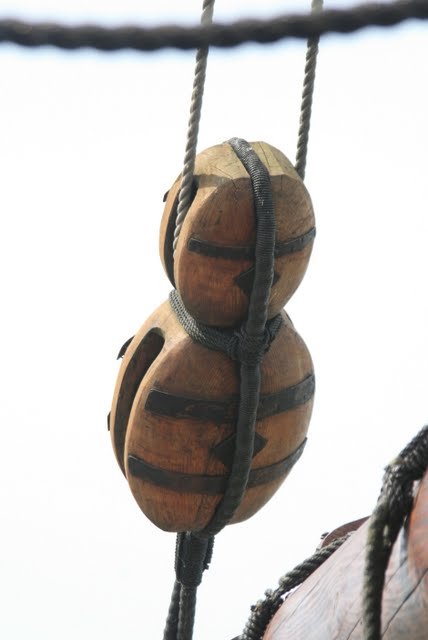
(If you do, please let me know, so I can use them for my next build
 )
)Jan
-
First those at the bowsprit, which gave a small problem in the attaching of the chain plates:
I used a method showed in Andersson: small eyebolts in the bowsprit, and rope lashings:
(my first seizings, took me ages to do)
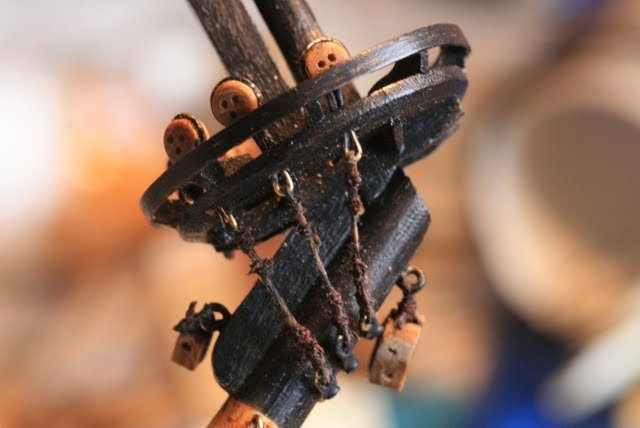
It was only later that I discovered that the Ketting-models uses long iron chains for these deadeyes.
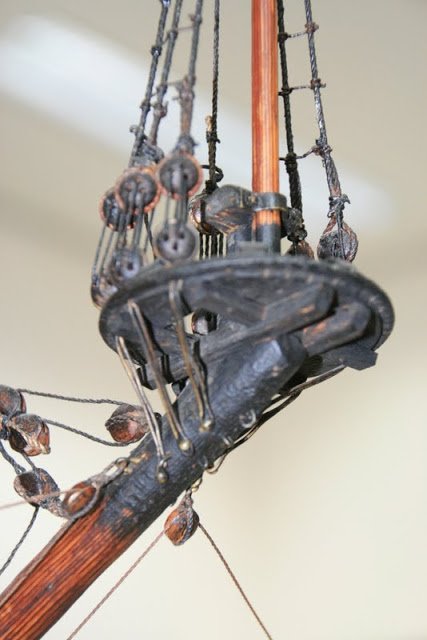
I wont redo them

Thane cam ethe tackles and shrouds of the fore mast:
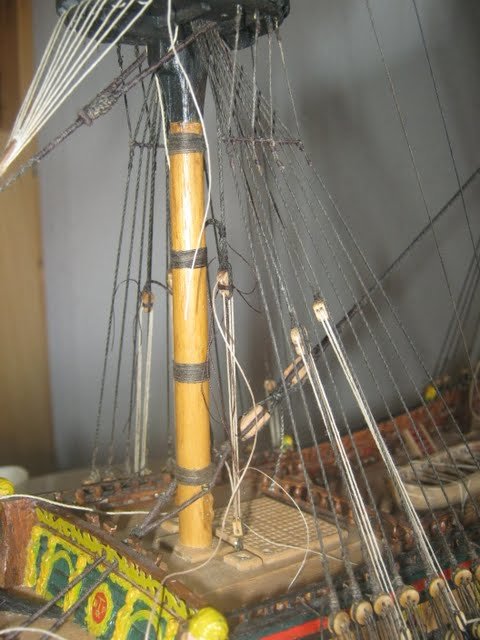
I had some discussion on the so called 'spreeworsten' (translation?) in the shrouds
Ketting shows them in such a way that they are spreading the shrouds. I followed this Ketting setup (which he aslo used in his model of the Prins Willem). However, some fellow modellers made it quite clear to me that this setup could never ever hold the strains that they woudl take in real life. However, too late to redo

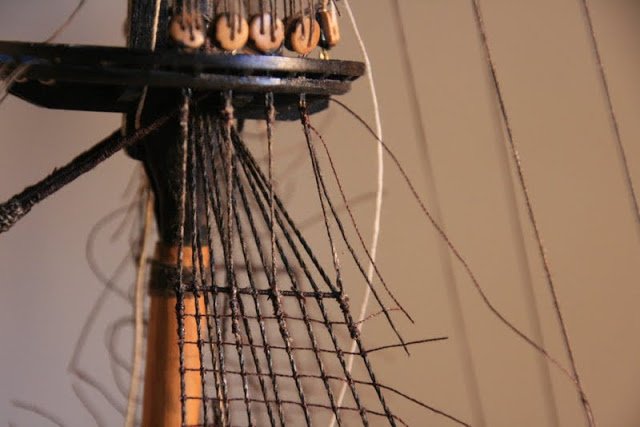
After setting up the shrouds the rattling down started. I finished teh foremast, but when clipping the loose ends, I managed to snap one of the futtocks. That forced me to remove the ratlines on the futtocks and do some surgery on the shroud. Still visible in the rightmost futtock, but acceptable when not viewed in 'macro-mode'

At the moment: shrouds is still work in progress:
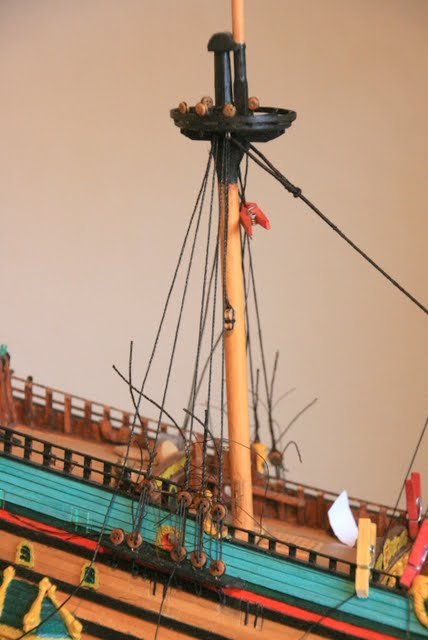
As is the rattling down: foremast done, main still to be started....
Jan
- dafi and avsjerome2003
-
 2
2
-
I tried to do some rope-work today, but it's just too cold at my bench ....
Therefore: just an old update on how things were two years ago.
After the masting, I had to start the rigging. After some thinking, I deceided to replace all Corel ropes with other material (as the thicker Corel stuff tended to be very uneven in thickness). I ordered Amati-stuf at Chantelle Wattons 'On-line hobby' store (I' ve no clue wheterh or not she is still - or again - in business. I also ordered lots of blocks, again, as the Corel stuff was a bit lousy made (holes not ending in the grooves, and double blocks that were single on one side.....)
For the stays, however, I had to do some home-made things. Starring my old lego (ropewalk) and meccano (serving)
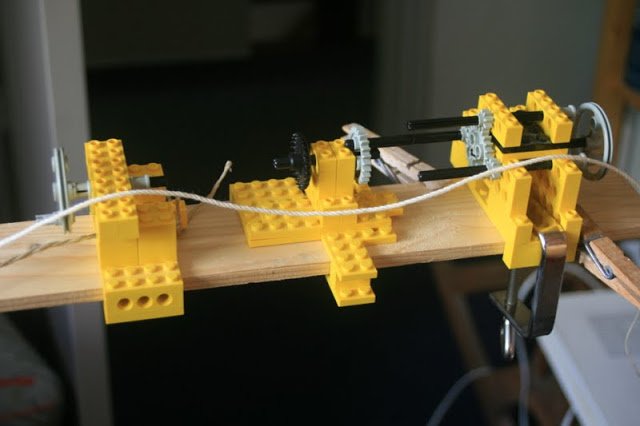
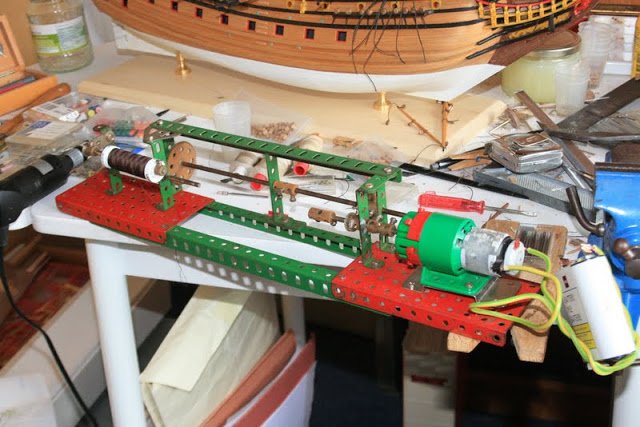
Using this machinery, I succeeded in making some nice stays, of the (almost) correct thickness.
I used beige thread, and stained it using some waterbased stains. (dark brown).
The serving is done with 0.15 mm Guterman thread (dark brown)
On the resulting rope, I made a mouse (using 0.5 mm thread).
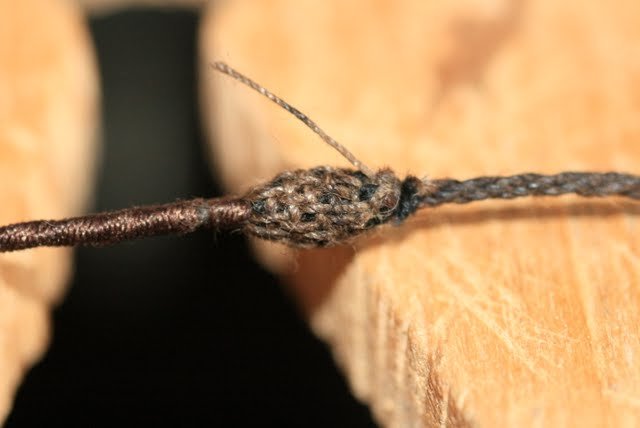
Nice eye (not a real splice, but some variation on what dafi has once posted under the titl eof 'power splice': use a needle to get the rope back through its own strands. No-one knows, due to the serving:
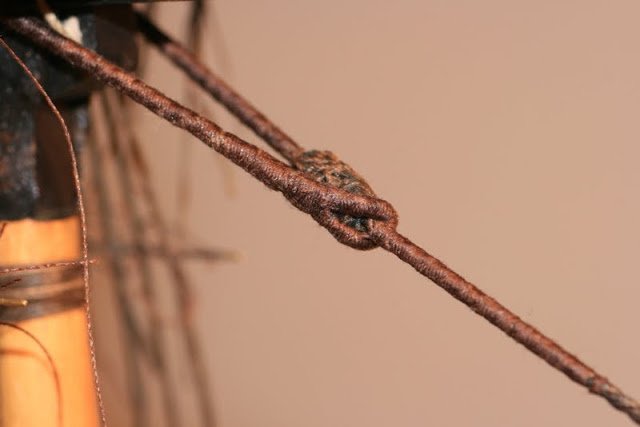
On the lower end, I made the large 5-hole blocks (later on I decided to stain them as well)
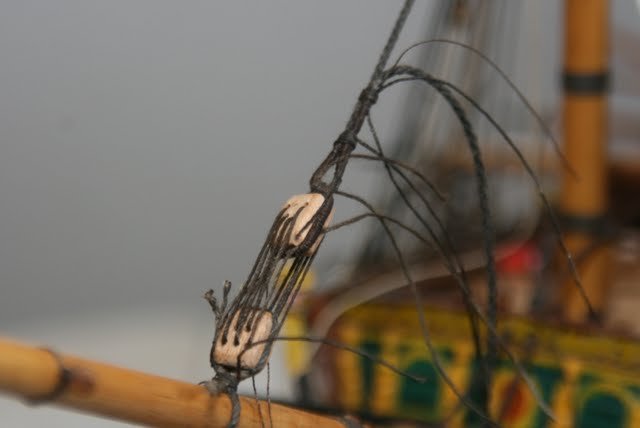
Finally, the crowsfeet were installed at the lower top:
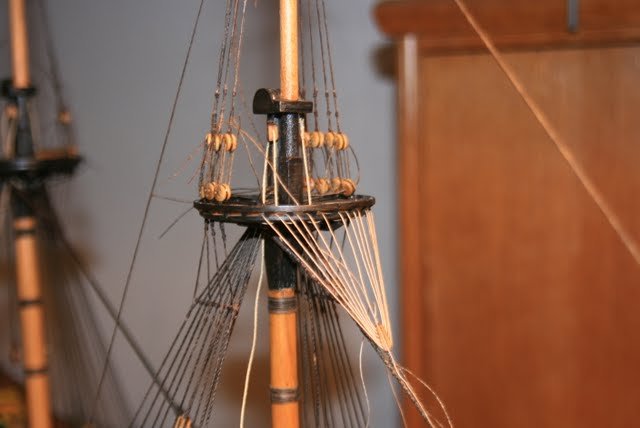
The more observant readers amongst you may notice that the crowsfeet were done after the shrouds were installed, and the main stay was in place (but recreating a log gies the advantage of sorting out things a bit by topic
 )
)Ofcourse, the same was done for the main stay, and the top-stays.
The main stay is attached using a block in a collar that is attached around the bowsprit:
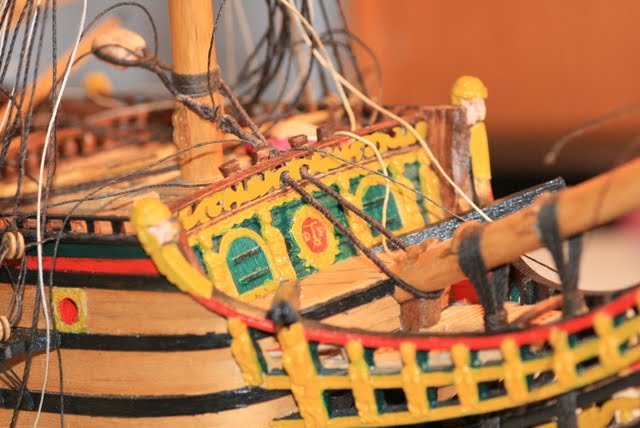
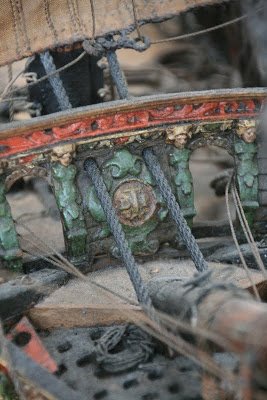
This is in line with the model in the Rijksmuseum Corel took as an example for this kit (see second pic),
but it should have been installed through a heavy knee at the stern. (however, when I discoverd that , it was too late to change....)
The crowsfeet for the main are not done yet.
The mizzen stay differs from the main and fore stay, as it is attached differently to the mast: not using a large 5-hole block, but a three-hole deadeye (5 mm diameter), stropped in a strop around the main mast:
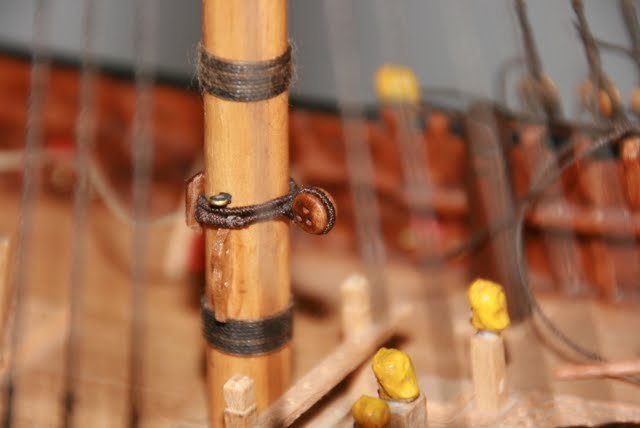
The uppermost stays are not installed using a mouse, but a fixed eye:
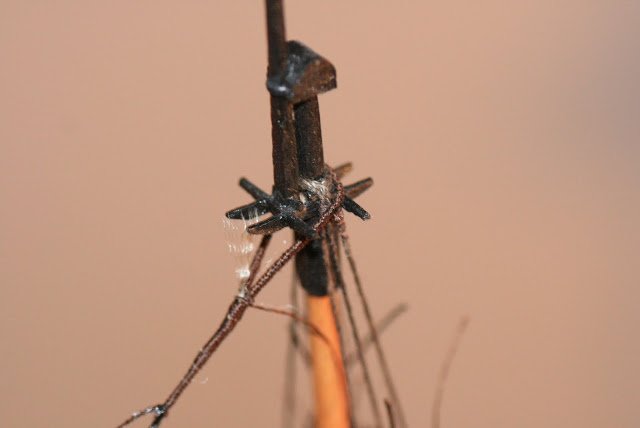
After taking this photo, I cleaned up a bit (removing the small strands of the rope coming out of the serving)
Literature is not quite clear on whether or not there was a mouse on these stays. Both methods are mentioned, and as my mousemaking ability was not good enough, I went for the splice...
Jan
- avsjerome2003 and dafi
-
 2
2
-
Not sure, depends on the ship and the country I suspect....
In the paperwork of the Zeven Provincieen (1666) both stay sails and spritsail topmast are mentioned.
The Lelystad reconstruction project published plans showing them both.
http://www.bataviawerf.nl/feiten-en-cijfers-van-de-7-provincien.html
Jan
-
Perhaps you should re-open the "name the great laker ship"-thread, that will show us down even more

Jan
-
Both your decision on the tiles and on the dragon's head were the right ones: it does look soooo much better now.
Aren't you affraid of discolouring of the paper you used for the tiles?
Jan
-
I have the building navy board stuyle and the sailing men of war.
There is considerable overlap in the three books, as some of the techniques are used in all types of ships.
The men of war is (as the title says) based on a large ship, the period ship modelmaking is the same on smaller ships (equal scale, thought).
The period ship modelsmaking is more explicit on the rigging. (Reed uses al kinds of meterials, the explanation is better in the book presented here)
I very much like the book on a navy board style model. (makes me dream of work to do in the future)
As the other books use a solid hull type approach, the navyboard style book is (by definition) not.
It gives quite a lot of pictures on how to do a miniature (1:196) navyboard style model. In its set up it is comparable to the other books: some basic info on workplace and tools needed, some on wood types, other materials (Reed is quite liberal in materials 'accepted'), Followed by what I would call a very extensively illustrated build log.
There is in this last book some overlap with the McNarry and McCaffery books on miniature modelling.
Jan
-
-
One of the major points you should tackle: the sheer of the planking towards the aft end of the ship is not correct:
you have your planks almost horizontal. In 'real life' it should more or less follow (or even be stronger) than the
upward curvature of the decks.
It should more or less follow the direction of the railing, and not that of the waterline.
Jan
-
The pic is an english copy of a drawing in Van IJk's book on Dutch shipbuilding.
Anderson is a good reference.
Anderson did republish his book, focussing more on the English rigging. So, if building a 'continental' ship, you should go for the earlier book.
Jan



Berlin 1674 by Model Mariner - scale 1:64 - Navy Board style
in - Build logs for subjects built 1501 - 1750
Posted
Another 'speedlog'
I marked myself as a follower!
Jan